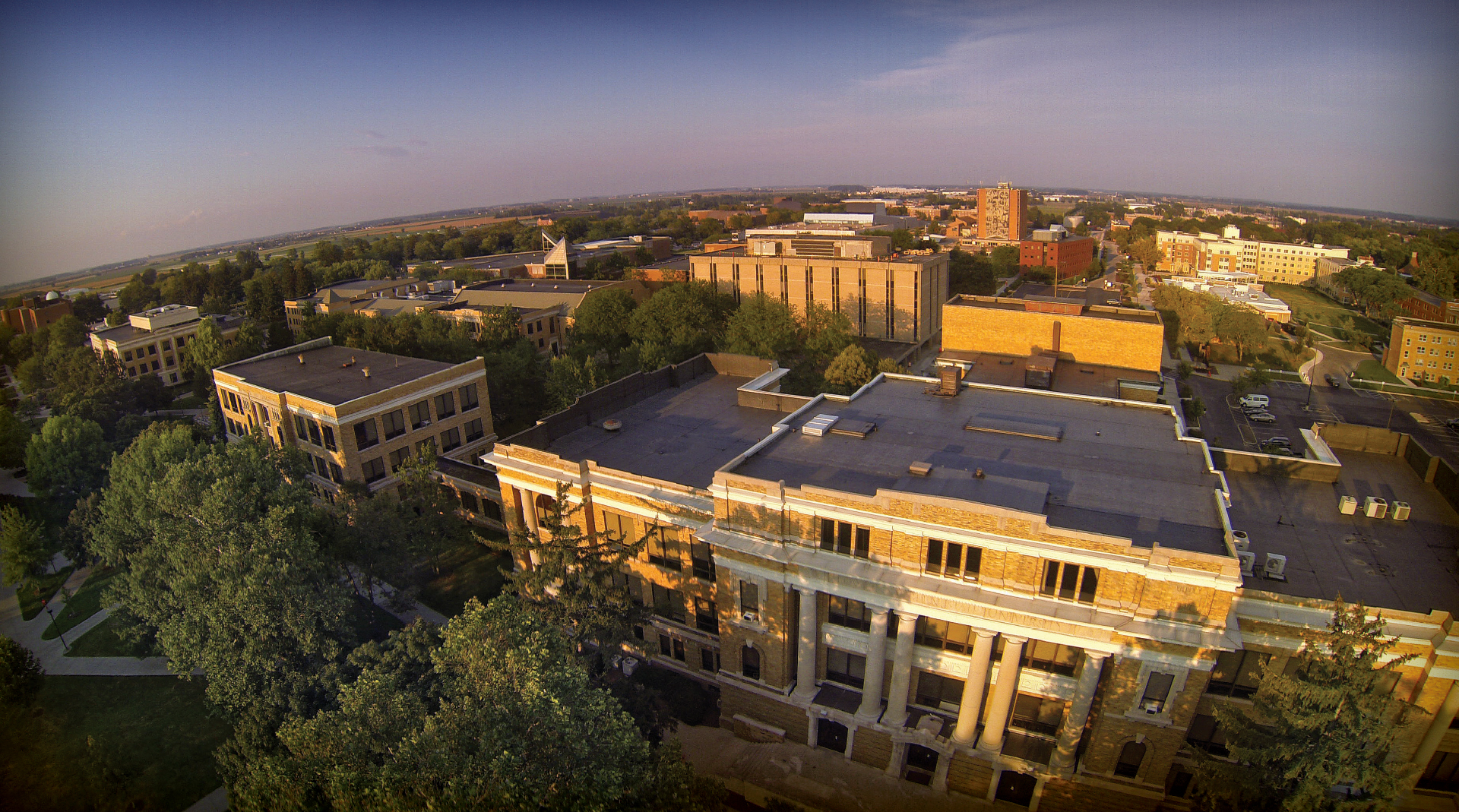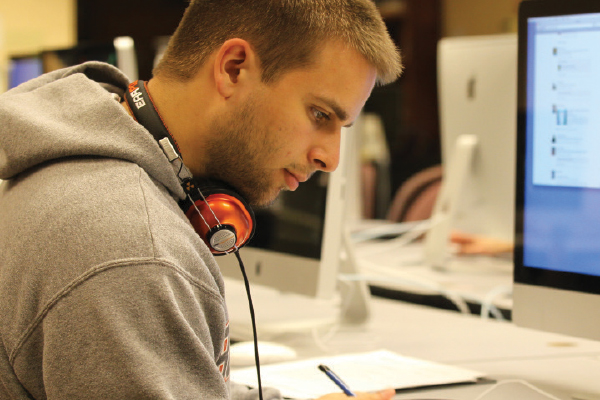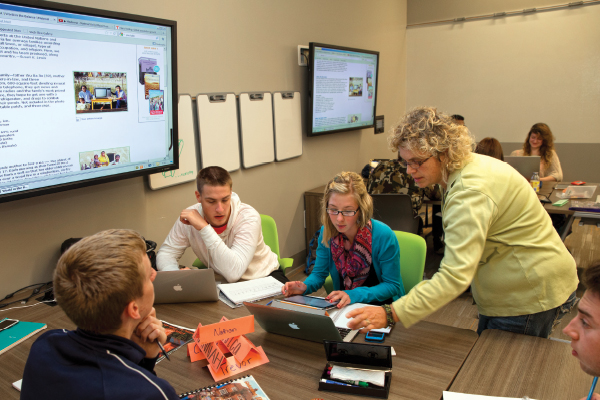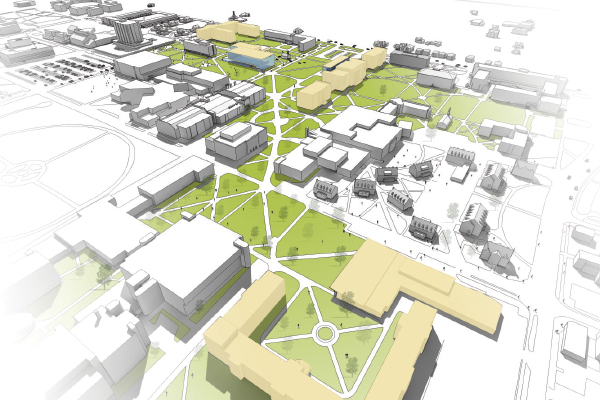
by Bonnie Blankinship

Building the Classrooms of the Future
Master plan includes next-generation learning spaces
by Bonnie Blankinship
The University is taking a multifaceted approach to improving student learning that includes instructional design and teaching methods as well as the physical spaces in which students study and learn. BGSU is dedicated to making learning more available and meaningful by fostering a symbiotic relationship among all those elements — plus technology. The Math Emporium will become a model for future active-learning adaptations planned across campus.
Olscamp Hall, opened in 1993 to serve as the University’s leading technology-equipped classroom facility, will be the first location of the Math Emporium. The Board of Trustees at its May meeting approved $5.65 million for the project, which is expected to be complete by the fall of 2014. Energy-efficient lighting, ceilings, floors and finishes will further the University’s efforts to be
environmentally sustainable.
The project will feature a 225-seat open area of computer systems clustered in various group configurations to accommodate individual or small group study, two 60-65 seat classrooms, a tutor oversight station, and several small testing rooms.

The active-learning classrooms will create learning spaces where instructors can experiment with a variety of academic technologies, teaching methods, and space configurations. Even the walls will be moveable to allow for different learning groups. Their designs are based on research, and faculty will receive training in how to utilize the technology available.
The Department of Mathematics and Statistics has redeveloped its program over the last few years to incorporate more computer-based skill development, and some sections of basic math classes are already using University-provided laptop computers.
“We’ve been experimenting with it, and the success rates have gone up significantly, so we know it’s working,” said Dr. Kit Chan, a professor and chair of the department. “This will just be implementing the program on a larger scale.”
The Math Emporium will facilitate a change in the way math courses are offered, allowing them to be broken down into one-credit modules that will string together to form three-credit courses. Students can move through the modules at their own pace, with supervision, retaking ones they do not pass without having to take the entire course again.

Faculty can provide more individualized instruction as they monitor each student’s progress.
“The machines can generate different problems as students complete the exercises, but the faculty can see where they are getting ‘stuck,’ and step in to offer help,” Chan said. “It’s a combination of humans and technology.”
The emporium also allows higher-level courses to be broken into classroom and lab components, whereby faculty would teach the concepts in the Mathematical Sciences building and students would further develop their skills in the emporium.
A team of math faculty, including Chan and Dr. David Meel, assistant chair of the department, visited other universities with math emporiums such as Virginia Tech, University of Alabama - Tuscaloosa and Kent State. They built BGSU’s program using some of what they observed but chose to incorporate much more of a “human element” into the program,” Chan said, adding, “We offer a lot more human help than they do.”
Until the Math Emporium is completed next year, a temporary, 90-seat “mini emporium” in Olscamp began serving students this fall, Chan said.
In addition to the Math Emporium, prototype active-learning classrooms have been built on Olscamp’s second floor and opened this fall. These are designed to promote cooperative and problem-based learning and to accommodate academic technology.
The classroom designs are based on the recommendations of the academic visioning group composed of BGSU faculty and students.

The changes to Olscamp will also allow it to serve as a “testing ground” for upcoming renovations to BGSU’s Traditions buildings of Moseley, University, Hanna and South halls. Faculty and student feedback will provide guidance on what is working best for BGSU.
The campus’s first active-learning classroom, in Hayes Hall, has been in use for about a year. Based on the “Minnesota Model,” it features fixed but centrally grouped round tables surrounded by
flat-screen monitors, with cabinets containing iPads and other devices. So far, it has garnered enthusiastic reviews from faculty and students, who report they like the ease of group and interactive work and the “workshop” atmosphere.
The College of Education and Human Development is also using elements of the active-learning classroom to prepare future teachers to use all the technology and methods available to meet their students’ needs.
“Learning is no longer situated in a particular time or space,” said Dr. Savilla Banister, director of BGSU’s Center for Excellence in 21st Century Educator Preparation. “We’re exploring what it means to be a 21st century teacher, student and lifelong learner.”
Updated: 12/01/2017 11:59PM
